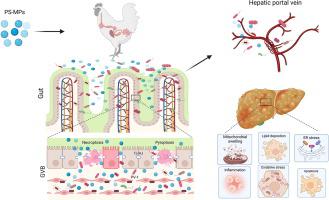Journal of Advanced Research ( IF 11.4 ) Pub Date : 2022-11-09 , DOI: 10.1016/j.jare.2022.10.015 Kai Yin , Dongxu Wang , Yue Zhang , Hongmin Lu , Yu Wang , Mingwei Xing

|
Introduction
Microplastic pollution seriously threatens the health and safety of humans and wildlife. Avian is one of the main species endangered by microplastics. However, the damage mechanism of microplastics to the digestive system of avian is not clear.
Objectives
The gut-liver axis is a bidirectional channel that regulates the exchange of information between the gut and the liver and is also a key target for tissue damage caused by pollutants. This study aimed to elucidate the digestive toxicity of microplastics in avian and the key role of the gut-liver axis in it.
Methods
We constructed an exposure model for microplastics in environmental concentrations and toxicological concentrations in chickens and reveal the digestive toxicity of polystyrene microplastics (PS-MPs) in avian by 16S rRNA, transcriptomics and metabolomics.
Results
PS-MPs changed the death mode from apoptosis to necrosis and pyroptosis by upregulating Caspase 8, disrupting the intestinal vascular barrier, disturbing the intestinal flora and promoting the accumulation of lipopolysaccharide. Harmful flora and metabolites were translocated to the liver through the liver-gut axis, eliciting hepatic immune responses and promoting hepatic lipid metabolism disorders and apoptosis. Liver injury involves multiple molecular effects of mitochondrial dynamics disturbance, oxidative stress, endoplasmic reticulum stress, and cell cycle disturbance. Furthermore, metabolomics suggested that caffeine and melanin metabolites may be potential natural resistance substances for microplastics.
Conclusion
Taken together, our data demonstrate the digestive damage of PS-MPs in avian, revealing a critical role of the liver-gut axis in it. This will provide a reference for protecting the safety of avian populations.
中文翻译:

聚苯乙烯微塑料对鸡消化毒性的剂量效应:多组学揭示肠肝轴的关键作用
介绍
微塑料污染严重威胁人类和野生动物的健康和安全。鸟类是受微塑料威胁的主要物种之一。然而,微塑料对禽类消化系统的损害机制尚不清楚。
目标
肠-肝轴是调节肠道与肝脏之间信息交换的双向通道,也是污染物引起组织损伤的关键靶点。本研究旨在阐明微塑料对禽类的消化毒性以及肠肝轴在其中的关键作用。
方法
我们构建了鸡体内微塑料的环境浓度和毒理学浓度暴露模型,并通过 16S rRNA、转录组学和代谢组学揭示了聚苯乙烯微塑料 (PS-MPs) 对禽类的消化毒性。
结果
PS-MPs通过上调Caspase 8、破坏肠道血管屏障、扰乱肠道菌群、促进脂多糖积累,改变细胞凋亡向坏死、焦亡的死亡模式。有害菌群和代谢产物通过肝肠轴转移到肝脏,引发肝脏免疫反应,促进肝脏脂质代谢紊乱和细胞凋亡。肝损伤涉及线粒体动力学紊乱、氧化应激、内质网应激和细胞周期紊乱等多种分子效应。此外,代谢组学表明咖啡因和黑色素代谢物可能是微塑料的潜在天然抵抗物质。
结论
综上所述,我们的数据证明了 PS-MP 对禽类的消化损伤,揭示了肝肠轴在其中的关键作用。这将为保护鸟类种群安全提供参考。









































 京公网安备 11010802027423号
京公网安备 11010802027423号